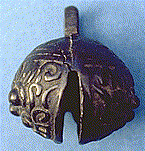 You are in the middle of the report.
You are in the middle of the report.If you have not passed the main screen, please click on the button.
Tiger bells South Asia
 Bangladesh Bangladesh
|  India India
|  Nepal Nepal
|  Pakistan Pakistan
|  Tibet Tibet
|
Click on one of the country names
 You are in the middle of the report.
You are in the middle of the report.
 Bangladesh Bangladesh
|  India India
|  Nepal Nepal
|  Pakistan Pakistan
|  Tibet Tibet
|
Click on one of the country names
Bangladesh
Tiger bells are of the B type.
Group: Unknown, probably common
Two type B tiger bells, one smaller, one larger, bought in Dacca but said to come from Chittagong. The smaller bell has square hoop, there are no Chinese characters. The other bell is of the larger B type.
Reported in 1988 by Anton Budde.
Two smaller tiger bells, bought in Dacca, said to come from Burma. On the top half of one of the bells are three characters which look more or less like the Roman 'SJS'.
Reported in 1988 by Annemiek Broersma.
India
Apart from the type B tiger bells in the Tibetan Refugee market in New Delhi, there is only one report: a tiger bell of the smaller type B, in a shop in Mahabalipuram (1990, Tamil nadu), now in the author's collection. No details were known and there are no other indications that tiger bells occur in this area.
However according to several shop owners and antique dealers in Nepal, tiger bells of the C type are produced until this very day in factories in Dehra Dunn (Uttar Pradesh, near the border with Himachal Pradesh) and Rajpur, for the Tibetan and Nepalese market.
Assam, Nagaland
Group: Naga
Several strands of small metal sequins, strung as necklaces, with two or three tiger bells and ordinary bells. The strands have probably been restrung for trading purposes. Originally they were much longer and were worn by Naga women around the upper body. The tiger bells are of an unusual type. Type A comes closest but the bells were probably newly made in the area.
Reported by Rinus van Huijksloot who has several of these strands in his shop, the Nusantara Museum shop in Delft (Neth). Also see several photographs in The Nagas, hill people of Northeast India by Julian Jacobs, published by Thames and Hudson.
Nepal
Tiger bells are of the C type, possibly type B and a roughly made variation of the A type.
Group: Unknown, probably common
A roughly made imitation of an A type bell. The 'Wang' character is present but apparently was not recognized by the maker. The shape is round with a square hoop. Author's collection (bought in 1976).

Several type C tiger bells, bought (1976), received (1986, from a.o. Hugo de Groote) and seen (1990) by the author. This type of bell is very common in Nepal. Many are newly made. One factory, in Dehra Dunn, produces these bells for the Tibetan and Nelalese market. Also Rajpur was mentioned as a place where tiger bells are produced. Both Dehra Dunn and Rajpur are in Uttar Pradesh (India).
New bells, sold as souvenirs
One tiger bell, probably type B, used by a medium from Tibet, now living in Kathmandu. The bell is attached to a chain worn across the chest, together with ordinary bells. Filmed during a demonstration of the medium in a film documentary on shamanism produced by Columbine film, Copenhagen (1986).
Several shaman's shoulder girdles and chains, with tiger bells and ordinary bells, for sale in Kathmandu antique shops. One chain with eight tiger bells and eight ordinary bells in author's collection (bought in 1990).
Pakistan
Tiger bells are of the A type.
Region: Campbellpore district
Five tiger bells, on a set of two wooden castagnets. Two tiger bells and two ordinary bells on one castagnet, three tiger bells and two small ordinary bells on the other. The castagnets were used by males during dances related to wedding ceremonies.
Bells are of the A type but roughly made (similar to some examples from East Kalimantan (Indonesia).
Collection Tropen Museum, Amsterdam (Neth.), procured in 1965.
Photograph: courtesy Elisabeth den Otter
Tibet
Tiger bells are mainly of the B type, one type A tiger bell and one tiger bell type C are reported.
Group: unknown, probably common
One type A tiger bell, probably used for dogs.
Collection: Leyden Ethnological Museum, procured in 1957.
One small type A tiger bell, silver plated, on a silver prayer mill.
Photographed in an antique shop in Singapore.
One bell type C, similar to those found in Nepal; on the catalogue card the country of origin, 'Tibet', is followed by a question mark. Leyden Ethnological Museum, collected in 1948.

Several belts, for yaks and horses, with eight to 10 or more large type B tiger bells.
Several belts and tiger bells were sold at the Tibetan Refugee market in New Delhi in the late seventies and early eighties.
There are belts in the Rotterdam Ethnological Museum and in the author's collection. From both belts, one bell is missing.
|
or go to the:  Introduction page Introduction page Reports of tiger bells in various countries Reports of tiger bells in various countries Description of various types of tiger bells Description of various types of tiger bells Observations and tentative conclusions Observations and tentative conclusions Reactions and opinions Reactions and opinions Table of distribution and use Table of distribution and use List of illustrations List of illustrations Home page Home page
|